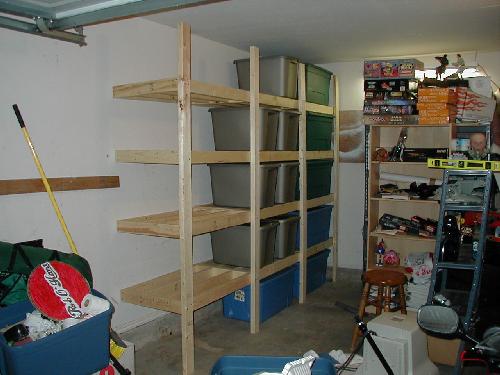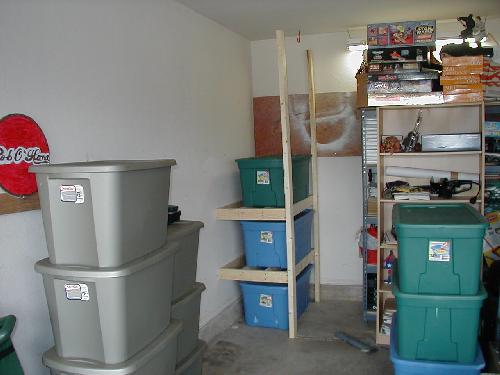Shortly after moving into our new home, I decided to build some shelves to hold all of my Rubbermaid Tubs. Rubbermaid storage tubs are great for storing stuff: they’re cheap, waterproof, and stack nicely. Unfortunately, they stack a little too nicely, which makes it difficult to retrieve things from the bottom of the stack!
I couldn’t find any good guides to building garage shelves on the Internet, so after a little planning this is what I came up with. I can’t say that these are the greatest looking or best laid out shelves ever, but what I CAN say is that YOU CAN MAKE THESE! If you need additional storage, you CAN do this! On a scale of 1 to 10, I’d rate my woodworking skills somewhere around a 3. If I can build these, anyone can! Also, I built these completely by myself — you won’t even need a friend’s help.

Materials Needed:
– 2x4s, 3″ wood screws, stud finder, tape measure, a square, a drill, a saw and some saw horses.
My original idea was to build the unit 5 shelves high. I have several 36-gallon tubs that are approximately 3-feet wide, and more 16-gallon tubs that (sideways) are about 17 inches wide. Based on that, I decided my shelves should be 3 feet wide so they could hold one big tub (sideways), or two smaller tubs (longways). That’s one good thing about building your own shelves — you can custom build them to meet your own needs! I then decided that my shelves would be 2 feet deep, mostly because it was an even number.
Let’s get started!
Here’s a 2×4. It’s 8 foot long. Doing some simple math, that will give us two 3-foot pieces, and one 2-foot piece.

After sawing up two 2×4’s, you’ll end up with four 3′ pieces and two 2′ pieces.

Ok, now this part’s kind of tricky. Balance a 2′ piece on top of the 3′ pieces. While it’s balanced, stick a couple of screws into each end.

The idea here is to build a square frame with two 2×4’s for support in the middle. If you wanted to cover the shelves with some particle board or plywood you might need no or only one support 2×4 in the middle — however, since I’m just stacking tubs on them and not smaller items, I opted for two 2×4’s. Since the end piece is 2′ long, I drew a couple of lines 8″ apart and screwed in the middle 2×4’s there.

Here’s where it starts to come together so read this paragraph closely. The way I make my shelves is by using whatever I’m going to put on the shelves as spacers. To do this, I used one of the tubs. Now, you don’t want to make your shelves exactly the same distance apart as the tubs, or they won’t fit! I used 2 VCR tapes for spaces on TOP of a tub as a guide to build my shelves. Take a look at the pictures, and it should make sense. It’s very easy, and makes your shelves all come out the same size!

Here are the first couple of shelves, already screwed into place. You’ll need two 2×4’s for the front support of the shelves. Now let’s put on that new shelf we just made!
Here is a tub in place, with two VHS tapes on each end.

Now we’ll put the shelf in place, resting it on top of the VHS tapes to give us an extra inch or two of space.

Here’s a shot of it from the side. See the extra space we get with the tape spacers?

It’s a good idea to throw a level on top of the shelf and make sure things are, well, level! It is, so let’s move on.

This is a stud finder. It finds the studs behind your wall, so you can screw into them. It’s a good idea to screw directly into studs when you can, since the wood will hold much more weight. Put a couple of screws into each stud you find. You will be surprised at how sturdy the end result is — I was easily able to climb up onto my shelves with no problem!

Once you remove the tub and tapes, voila! Another shelf has been added! Keep going up until you run out of room.

Here we are with three shelves in place. Looks like room for one more for me.

And this is what it looks like with four shelves! If you’re going to expand out (like I planned), I overlapped the front 2×4 support. In other words, the shelves are screwed into the right half of the shelves, leaving room for more shelves to the left. You can basically repeat this until you run out of either wood, tubs, or wall space.

The idea of adding on is the same. Set up a tub, put VHS tapes on top for spacers and slide your shelf into place. There should be enough studs so you’ll have at least 2 per shelf.

Take another look at the front 2×4 support. See how I only used half? The new shelf will be screwed into the remaining half.

Like I said, you can keep repeating this as many times as needed. Here are two completed sections …

… and, here are three!

2×4’s are about $2.50 each here. Since I used two 2×4’s per shelf, that means each shelf costs $5 to build. On top of that price, you’ve got your screws and tools, if you didn’t already have them. I can tell you at Lowes, that level cost about $3, the orangle plastic triangle square was $5, and the 5lb box of screws was $20. I used about 1/10th of the box of screws. The tape measure was a buck at Big Lots.
From here, I plan on extending the shelves out two more sections. On these, I’m going to cut pieces of wood for each shelf, so I can stack smaller odds and ends in them. Basically it should cost about the same, as the price of the wood is basically the same as the cost of the extra 2×4’s I’ll be able to leave out.








